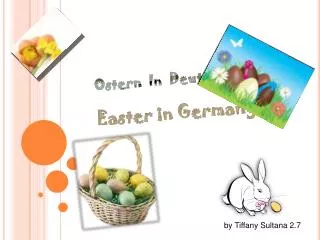Ostern in Deutschland
401 likes | 1.8k Views
Ostern in Deutschland. By Elizabeth Azzopardi Form2.07. EASTER IN germany. If you happen to be in Germany during Easter and a passer-by greets you with the words 'Frohe Ostern', don't be taken aback. He is only wishing you a 'Happy Easter', as 'Ostern ' is the German word

Ostern in Deutschland
E N D
Presentation Transcript
Ostern in Deutschland By Elizabeth Azzopardi Form2.07
EASTER IN germany If you happen to be in Germany during Easter and a passer-by greets you with the words 'Frohe Ostern', don't be taken aback. He is only wishing you a 'Happy Easter', as 'Ostern' is the German word for Easter. The Cross is covered on Good Friday, when Germans eat fish delicacies. Easter in Germany starts by the celebration of holy mass in churches, on Saturday evening, which continues until dawn on Sunday. On Easter Sunday, families gather for the holy Easter lunch, which is served with coloured eggs and a lamb-shaped cake,among other traditional recipes. Children in Germany are very fond of receiving the attractively decorated Easter eggs as gifts from their parents and elder family members on this day.
Easter Celebration In Germany Germany is regarded as the birthplace of the Easter bunny and Easter tree. German kids were told of an "Easter bunny" (Osterhase) that hid eggs and chocolates for children to find on Easter Sunday. German immigrants to America - particularly Pennsylvania - brought the tradition with them and spread it to a wider public. Today, Easter eggs are exchanged as presents in Germany. The tradition of egg tree is also popular in Germany. The eggs used for cooking Easter meals are not broken, but are emptied by blowing the contents into a bowl, through pinholes at either end of the egg. The hollow eggs are then beautifully decorated and hung from shrubs and trees, during Easter week.
Easter tree The Easter tree, (der Osterbaum), another symbol associated with the celebration of Easter in Germany, is embellished beautifully with hollowed eggs, which are dyed and hung with colourful ribbon. The decoration of the Easter tree which has it’s origins in Germany is very popular and is considered an opportunity to spend some quality time with family and close friends.
Traditional Food The main day of German Easter celebrations is Easter Sunday. For Christians it is a time for the whole family to get together to celebrate the resurrection of Jesus Christ and the end of the Lent with a festive meal. A more festive breakfast is often on the menu since families have more time to relax and enjoy a more leisurely brunch-type meal after the children have exhausted themselves looking for Ostereier from the Osterhase!
Bunny Cake Ingredients: 2 cups all-purpose flour1/2 cup shortening1 1/2 cup sugar1 cup milk3 1/2 tsp baking powder1 1/4 tsp vanilla1 tsp salt3 eggs Frosting: 1 3-ounce package cream cheese, softeneda pinch of salt1 tbsp milk2 1/2 cups confectioners' sugar1 tsp vanilla Cooking: Preheat the oven to 350 degrees F (180 degrees C). Grease and flour the cake pans (rub bottom of pan with butter or shortening, then sprinkle flour in the pan; tap the pan until flour spreads and covers the bottom). Sift the flour, sugar, baking powder, and salt into the electric mixer bowl. Add the shortening, milk, vanilla, and eggs. Mix on low speed for one minute. Scrape the sides of the bowl, then turn mixer to high speed. Beat for 3 minutes. Pour into pans and bake for 30 to 35 minutes, or until a wooden pick inserted in the cake centre comes out clean (not sticky!). Cool in pans for 10 minutes, then turn cake layers onto a wire rack (you might need help with this step).
Easter Market A few weeks before Easter Sunday in Germany, you can also see in many towns an Easter Market, called Ostermarkt in German, where they sell decorated Easter eggs, chocolate eggs and bunnies, spring ornaments and more Easter crafts. Germans love to decorate their house and garden with Easter decoration. Many of these Easter decorations come directly from the pagan Frühlingfest's (spring fête) symbols of fertility such as the egg (Ei) and the rabbits (Hasen) that became the Ostereier (Easter eggs) and the Osterhasen (Easter bunnies). As we have seen, Easter in Germany has a few customs of its own such as the "Osterbaum" (the Easter Tree) and the "Osterbrunnen" (Easter Fountain).
Easter egg market An Easter egg with a floral and rabbit design carved into it on sale at the Easter egg market in Seligenstadt, Germany. Helmut Meister carefully applies miniature glass pearls to a wax coated egg at an Easter Egg market in Selgenstadt, Germany. The markets are popular places in the Easter season, and collecting eggs can be an expensive hobby. Here an artist, dressed in traditional garb, decorates Easter eggs with Silesian designs, as seen in the foreground.
An artist uses a knife to scrape away the colour as he decorates the egg. The egg at centre wishes you a happy Easter! These eggs are decorated with couples in traditional dress from different areas of Germany. These chicken, duck and goose eggs were coated with a special wax before the coloured beads were pressed into them to make the designs.
It takes talent and a steady hand to decorate an Easter egg like this. I wish you: FROHE OSTERN!


